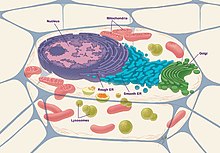Cell biology
These have allowed for and are currently being used for discoveries and research pertaining to how cells function, ultimately giving insight into understanding larger organisms.Due to advancements in microscopy, techniques and technology have allowed scientists to hold a better understanding of the structure and function of cells.Pyruvate undergoes decarboxylation using the multi-enzyme complex to form acetyl coA which can readily be used in the TCA cycle to produce NADH and FADH2.These products are involved in the electron transport chain to ultimately form a proton gradient across the inner mitochondrial membrane.[27] Metabolism in plant cells includes photosynthesis which is simply the exact opposite of respiration as it ultimately produces molecules of glucose.[29] The ancestry of each present day cell presumably traces back, in an unbroken lineage for over 3 billion years to the origin of life.Sexual processes in eukaryotes, as well as in prokaryotes, provide an opportunity for effective repair of DNA damages in the germ line by homologous recombination.Cdks, associated cyclin counterparts, protein kinases, and phosphatases regulate cell growth and division from one stage to another.[34] The cell cycle is controlled by the temporal activation of Cdks, which is governed by cyclin partner interaction, phosphorylation by particular protein kinases, and de-phosphorylation by Cdc25 family phosphatases.These are not dormant times; they are when cells gain mass, integrate growth factor receptors, establish a replicated genome, and prepare for chromosome segregation.Only a few forms of DNA damage are mended in this fashion, including pyrimidine dimers caused by ultraviolet (UV) light changed by the insertion of methyl or ethyl groups at the purine ring's O6 position.[37] Mitochondria are commonly referred to as the cell's "powerhouses" because of their capacity to effectively produce ATP which is essential to maintain cellular homeostasis and metabolism.Furthermore, the OMM connects to other cellular organelles, such as the endoplasmic reticulum (ER), lysosomes, endosomes, and the plasma membrane.Mitochondria can exist as independent organelles or as part of larger systems; they can also be unequally distributed in the cytosol through regulated mitochondrial transport and placement to meet the cell's localized energy requirements.Mitochondrial dynamics refers to the adaptive and variable aspect of mitochondria, including their shape and subcellular distribution.Additionally, autophagy has antiviral and antibacterial roles within the cell, and it is involved at the beginning of distinctive and adaptive immune responses to viral and bacterial contamination.When macro autophagy is triggered, an exclusion membrane incorporates a section of the cytoplasm, generating the autophagosome, a distinctive double-membraned organelle.Autophagy instability leads to a variety of illness symptoms, including inflammation, biochemical disturbances, aging, and neurodegenerative, due to its involvement in controlling cell integrity.The phagophore approach indicates dysregulated polypeptides or defective organelles that come from the cell membrane, Golgi apparatus, endoplasmic reticulum, and mitochondria.The auto-phagosome combines with the lysosomal vesicles to formulate an auto-lysosome that degrades the encapsulated substances, referred to as phagocytosis.


Cell (biology)BiologyOutlineGlossaryHistorytimelineCell theoryEcosystemEvolution PhylogenyAdaptation Energy processingGrowthRegulationReproductionResponse to environment DomainsKingdomsArchaeaBacteriaEukaryaAnimalsPlantsProtistsAbiogenesisAerobiologyAgronomyAgrostologyAnatomyAstrobiologyBacteriologyBiochemistryBiogeographyBiogeologyBioinformaticsBiological engineeringBiomechanicsBiophysicsBiosemioticsBiostatisticsBiotechnologyBotanyCellular microbiologyChemical biologyChronobiologyCognitive biologyComputational biologyConservation biologyCryobiologyCytogeneticsDendrologyDevelopmental biologyEcological geneticsEcologyEmbryologyEpidemiologyEpigeneticsEvolutionary biologyFreshwater biologyGenerative biologyGeneticsGenomicsGeobiologyGerontologyHerpetologyHistologyHuman biologyIchthyologyImmunologyLipidologyMammalogyMarine biologyMathematical biologyMicrobiologyMolecular biologyMycologyNeontologyNeuroscienceNutritionOrnithologyOsteologyPaleontologyParasitologyPathologyPharmacologyPhotobiologyPhycologyPhylogeneticsPhysiologyPomologyPrimatologyProteomicsProtistologyQuantum biologyRelational biologyReproductive biologySociobiologyStructural biologySynthetic biologySystematicsSystems biologyTaxonomyTeratologyToxicologyVirologyVirophysicsXenobiologyZoologyBiologistList of biology awardsList of journalsList of research methodsList of unsolved problemsAgricultural scienceBiomedical sciencesHealth technology Pharmingstructurefunctionprokaryoticeukaryotic cellscell metabolismcell communicationcell cyclecell compositionmicroscopy